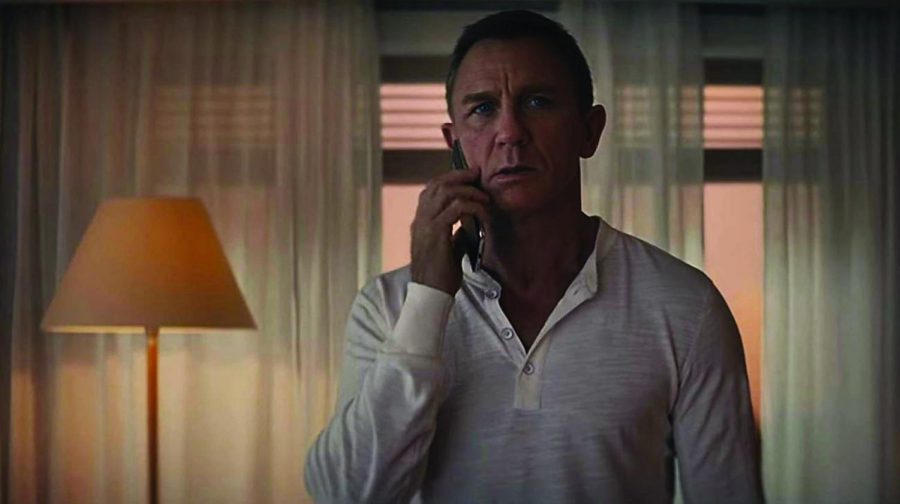A farewell to Bond in “No Time to Die”
Film Critic Hunter Friesen gives 4/5 for the last James Bond movie that Craig will do. This is Craig’s fifth Bond movie.
Oct 11, 2021
Since his first cinematic appearance in 1962, James Bond has done a lot of things. He’s been reincarnated five times, traveled around the globe (including space), and saved the world more times than it deserves. But the one thing that James Bond has never done is venture inward. For one of the first times in the franchise, the emotional beats are what pump the blood within the film’s heart. The theme of finality rings loudly, as “No Time to Die” marks the twenty-fifth entry in the long-running series, as well as the fifth and final part of the Daniel Craig era.
In a move that has become routine by now, Bond has left active service. This time it wasn’t because of being presumed dead (even though that is true here), but because of his love of Madeleine Swann, a daughter of SPECTRE. Their attempt at a normal life goes about as expected, with bad guys ruining their Italian honeymoon. This, along with a deadly theft of a weaponized virus in the heart of London, brings James back into the fold for one last mission. Not one for nostalgia, MI6 moved on from Bond and promoted a new 007 named Nomi, who embodies the new school of espionage. Along with M, Q, Moneypenny, and Tanner, it’s time once again for the forces of good to vanquish evil.
The Craig era marked the MCU-ification (a term that shouldn’t be taken as derogatory) of the Bond franchise, as it turned against the standalone nature of the previous entries and started to treat subsequent films as true sequels. The events of “Casino Royale” fed directly into “Quantum of Solace.” And when that movie failed, “Skyfall” acted as a soft reboot, later filtering into “Spectre.” “No Time to Die” pulls double duties by playing as a direct sequel to “Spectre,” but also the final bow on the whole modern Bond era.
Despite the interconnectedness, long-time writers Neil Purvis and Robert Wade don’t want to be restricted by franchise ties. There has never been a need to see a previous movie to comprehend the next one, with only tried and true franchise elements such as Ernst Stavro Blofeld and SPECTRE providing an integral throughline.
The duo always seems to be stuck in the past with their scripts, mining the same bits, such as shaken not stirred martinis, Aston Martin cars, and megalomaniac villains hellbent on world domination. The blame for the forgettable plot – borderline incoherent at times – should rest on their shoulders.
Lacking the personal connection of Christoph Walz’s Blofeld and Javier Bardem’s Raoul Silva, Rami Malek’s Lyutsifer Safin is a second-rate Bond villain. The casting choice itself is a no-brainer, as Malek has a heavy natural supply of VE (Villain Energy). Safin seems to be a character lifted from a Shakespearean play, as he often poetically monologues into the middle-distance. There’s unintentional ironic humor to Safin’s plan of decimating the world’s population through a virus, as it requires much more effort than what COVID-19 has been able to do.
It’s co-writer/director Cary Joji Fukunaga (first American Bond director) and “Fleabag” scribe Phoebe Waller-Bridge that want to take the franchise in a newer direction. There’s an element of fun introduced that has been missing from the Craig films. Doing well to supply that is Ana de Armas, who does too well with too little screen time in a “Knives Out” reunion. There’s also the pairing of Bond with Nomi, played terrifically by Lashana Lynch, and who is much more than the alleged SJW-takeover that some want you to believe.
With their record-breaking budgets, the Bond films have always had nice toys to play with. They just needed the right person to harness their potential. Fukunaga breaks the stoic shackles set by “Skyfall” and “Spectre” director Sam Mendes, returning Craig back to the kinetic destruction wonderfully employed in “Casino Royale.” There’s a particular long-take stairwell scene, similar to the one Fukunaga used in “True Detective,” that perfectly illustrates Bond’s otherworldly combat skills. And there’s the shoutout in Cuba, which plays more like a dance as Bond and Nomi attempt to retrieve a precious item.
It’s a testament to Craig that he’s been able to keep up with the physical requirements of the role, especially with the battle scars he’s accumulated over the years. But he also reaches new heights emotionally, with his Bond being the most vulnerable, both literally and metaphorically. He shares more than an animalistic sexual relationship with his Bond girls. There’s something palpable under the surface, keeping you invested beyond just the setpieces.
With a lot of time (163 minutes in fact) to end, “No Time to Die” says goodbye to the actor who ushered in a new era for James Bond. Thankfully, it does it with a sly wink and a nod to what could be in store for this long-weathered franchise.
Overall: 4/5









